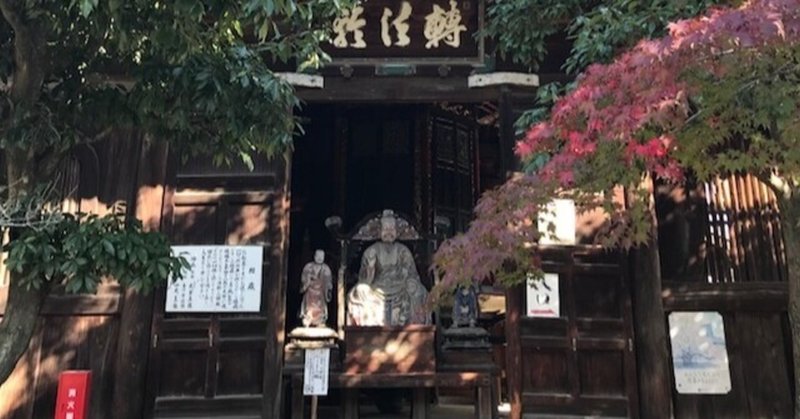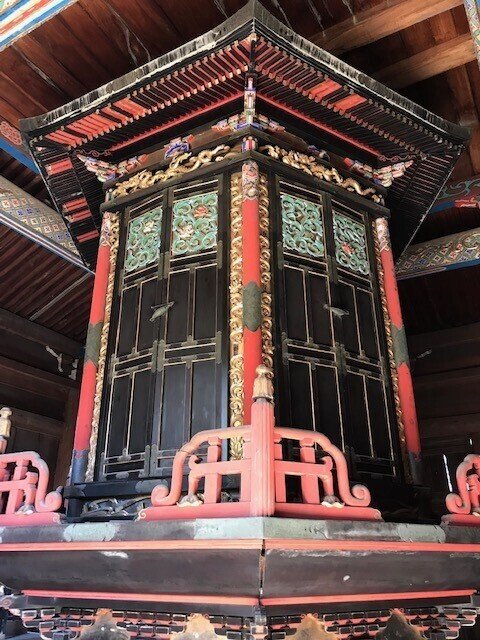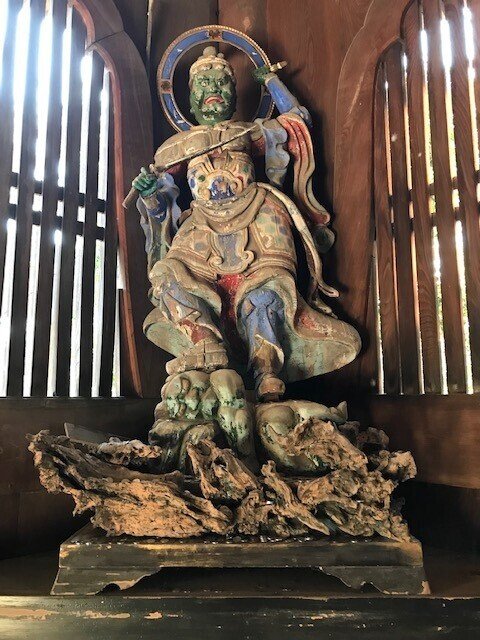
清凉寺の一切経蔵で気がみなぎる Feel at full of energy in the Issai Kyozo of Seiryo-ji Temple
清凉寺(嵯峨釈迦堂)の境内には見どころがたくさんあるが、一切経蔵(いっさいきょうぞう)もそのひとつ。トップ写真にあるお堂が「一切経蔵」で、別名「輪蔵(りんぞう)」といわれている。正面に祀られているのは「傅大士(ふだいし)父子像」。「傅大士」は、見てのとおり笑顔の像で別名「笑い仏」ともいわれている。
There are many attractions in the precincts of Seiryo-ji Temple (Saga Shakado), and Issaikyozo is one of them. The temple in the top photo is "Kyozo", also known as "Rinzo". Enshrined in the front is the "Fudaishi Father and Son Statue". As you can see, "Daishi" is a smiling statue and is also known as "Laughing Daishi".

一切経(大蔵経)とはある特定の仏教経典を指すのではなく、経・律・論の三蔵を中心としたあらゆる仏典のことをいう。仏典はお釈迦様の没後に書かれたものであらゆる言葉に訳されているが、それらすべての総称が大蔵経といわれている。
lssai sutras (Daizo sutras) does not refer to any particular Buddhist scriptures, but to all Buddhist scriptures centered on the Sanzou of sutras, vinayas, and theories. The Buddhist scriptures were written after the death of Buddha and translated into all kinds of words, but all of them are collectively called the Daizo Sutra.
その大蔵経の仏典を収納しているのが輪蔵(りんぞう)で、仏教の寺院内等に設けられる経蔵の一種で転輪蔵とも呼ばれている。 経蔵の中央にある、中心軸に沿って回転させることが可能な八角形の書架。いま風にいうと回転式書架ということになる。
一般には、この経蔵を回転させ、読みたい経典を取り出す仕組みになっている。この書架は文字の読めない人物にも、修学する環境のない人物にも広く仏縁があるように時計回りに一回転させることで、一切経全巻を読誦したのと同等の御利益が得られると信じられている。
遠目にしか見ることの出来ない寺院が多い中、ここ清凉寺では自身で回せるのが特徴である。その輪蔵は、傅大士が考案者ということで一切経蔵の正面には、傅大士とその二子の三尊像が奉安されている。
堂内の四隅には四天王像が輪蔵を囲っている。天部の仏神である持国天、増長天、広目天、多聞天の四天王の勇ましい姿が見られる。
The Rinzo is the storage of the Buddhist scriptures of the Daizo Sutra, which is a type of sutra that is set up in Buddhist temples and is also called the Rinzo. An octagonal bookshelf in the center of the Kyozo that can be rotated along the central axis. In modern terms, it is a rotary bookshelf.
Generally, the mechanism is to rotate this sutra and retrieve the scripture you want to read. I believe that this bookshelf can provide the same benefits as reading the entire volume by turning it clockwise so that there is a wide range of Buddhist ties to both people who cannot read letters and people who do not have an environment to study. Has been done.
While there are many temples that can only be seen from a distance, the characteristic of Seiryo-ji is that you can turn it yourself. Since the Buddhist texts were invented by the Buddhist texts, the statues of the Buddhist texts and his two sons are enshrined in front of the Buddhist texts.
At the four corners of the hall, statues of the four heavenly kings surround the wheel storehouse. You can see the brave figures of the four heavenly kings of the Buddhist gods of the heavens, Jikokuten, Zochoten, Komokuten, and Tamonten.

輪蔵
持国天は、東方を護る守護神として造像される場合が多く、通常、仏堂内部では本尊に向かって右手前に安置される。その姿には様々な表現があるが、日本では一般に革製の甲冑を身に着けた唐代の武将風の姿で表されている。
Jikokuten is often imaged as a guardian deity that protects the east, and is usually placed in front of the main temple inside the Buddhist temple. There are various expressions for its appearance, but in Japan it is generally represented by the appearance of a Tang dynasty military commander wearing a leather armor.

持国天
広目天は、西方を護る守護神として造像されることが多い。仏堂内では本尊向かって左後方に安置される。持国天とおなじように革製の甲冑を身に着けた唐代の武将風の姿で表される。
Komokuten is often imaged as a guardian deity that protects the west. In the Buddhist temple, it is enshrined on the left rear side facing the principal image. It is represented by the appearance of a Tang dynasty military commander wearing a leather armor, similar to Jikokuten.

広目天
増長天は、南方を護る守護神として造像され、仏堂では本尊に向かって左手前に安置される。その姿は、持国天、広目天と同じである。
Zhochoten is imaged as a guardian deity that protects the south, and is enshrined in the Buddhist temple on the left side facing the principal image. Its appearance is the same as that of Jikokuten and Komokuten.

増長天
そして北方を護る守護神である多聞天は、独尊像として造像安置する場合は「毘沙門天」と呼ばれている。
Tamonten, the guardian deity that protects the north, is called "Bishamonten" when it is enshrined as a Buddha statue.

多聞天
多くの寺院では一切経蔵への入堂がかなわないが、ここ清凉寺では自身の手で押して功徳を得ることができる。見るからに時代を経た古い建造物に見えるが、堂内に入ると空気は一変する。本堂に手を合わせると同じように、一切経蔵の輪蔵に触れると気が高揚してくるのがわかる。
Many temples do not allow you to enter the Issai Kyozo, but here at Seiryo-ji you can push it with your own hands to gain merit. It looks like an old building, but when you enter the hall, the air changes completely. Just like when you put your hands on the main hall, you can see that when you touch the Buddhist texts of the Issai Kyozo, you will feel uplifted.
リポート&写真/ 渡邉雄二 一切経蔵についてはウィキペディアを参照 Reported & Photos by Yuji Watanabe
よろしければサポートお願いします。日本の伝統文化に関心を寄せています。若いころに文化圏の異なる地域の方たちとの交流で日本のことをあまりにも知らなかったことに気づかされ、それがきっかけで広く浅く学んでいます。拙いレポートですが、お目に留めていただければ幸です。
